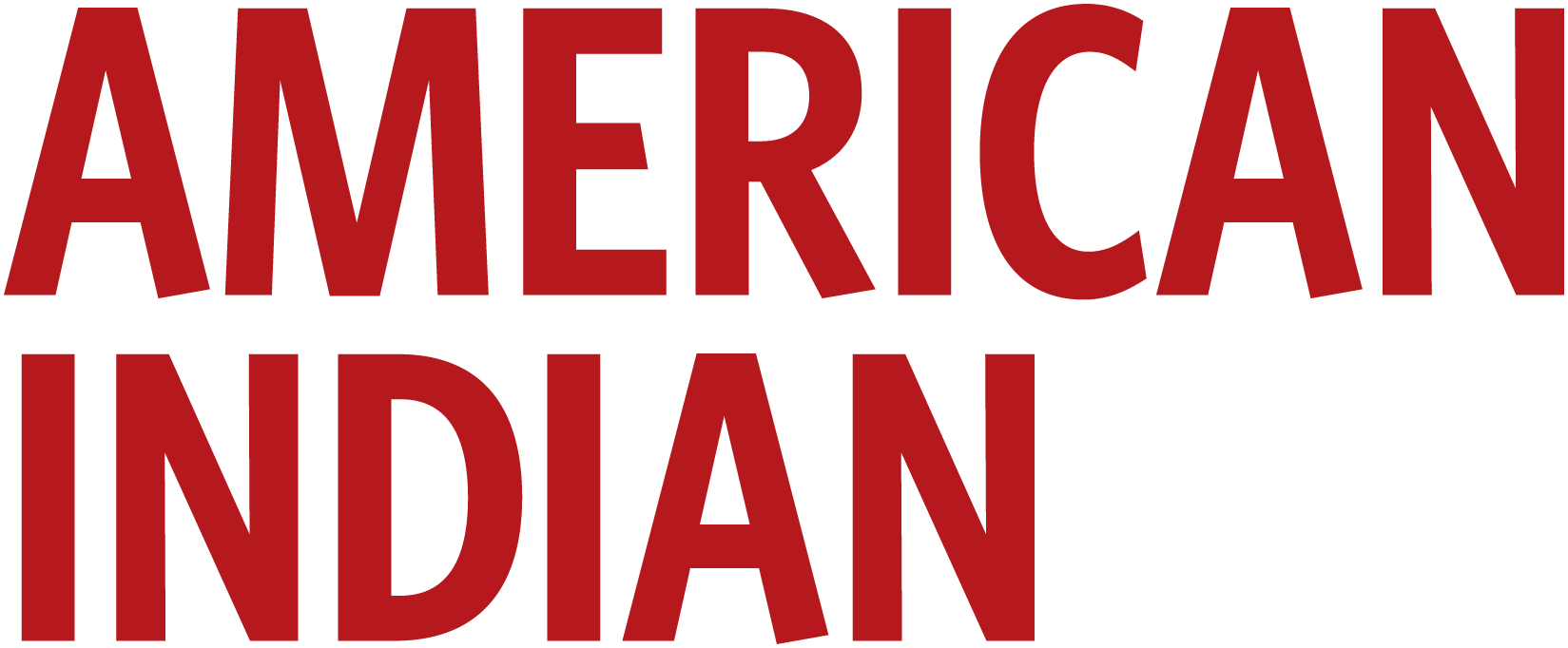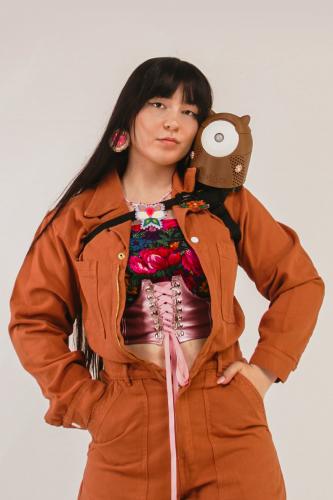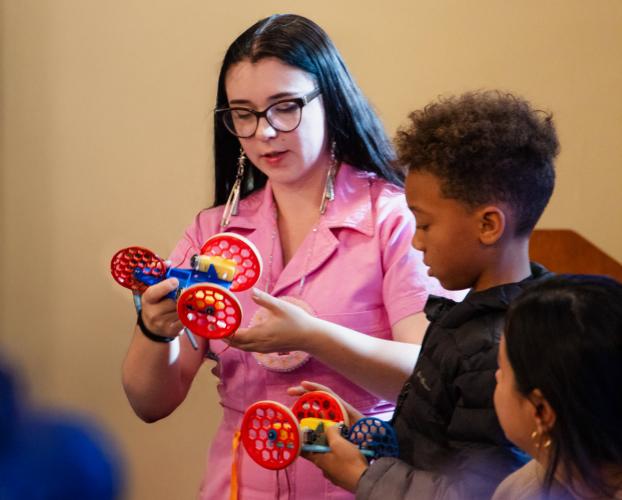Amid the screwdrivers, electronic parts and 3-D printers of her engineering workshop in San Diego, Danielle Boyer is talking with a small creature. The dome-headed, tan-colored robot is about the size of a kitten and has tiny, upright ears and an intricate, flowered face. “Listen,” Boyer says to it. “What is ‘hello’?” Speaking in a child’s voice, the robot answers in Anishinaabemowin, her Anishinaabe language: “Boozhoo” (pronounced boo-zhoo).
This robot and hundreds of others like it were designed and built by Boyer, who is a member of the Sault Ste. Marie Tribe of Chippewa Indians, one of the many tribes of the Anishinaabe peoples. She is an engineer and inventor on a mission to use science and technology to preserve Indigenous languages such as her own because, she said, “if you lose your language, you lose your culture.” She taught herself to build robots and works with students to develop technologies to teach Indigenous languages. She has also distributed thousands of free robot-making kits to youth across the United States.
Boyer is a leading voice about the ethics of using artificial intelligence (AI) and other technologies with Indigenous cultures. She has spoken at high-profile venues, such as the United Nations Educational, Scientific and Cultural Organization in Paris this past spring. Earlier this year, she was named a National Geographic Young Explorer and a Washington Post “Next 50” honoree as one of 50 people shaping our society in 2025.
And she has accomplished all this by the age of 24. “I see myself as someone who’s always learning,” Boyer said.
Boyer grew up in Detroit and on the Sault Ste. Marie Tribe reservation in upper Michigan. She was homeschooled by her Anishinaabe mother and also learned about her Indigenous culture through oral traditions and storytelling from her Anishinaabe maternal grandmother. But then when she was a teenager, Boyer saw her younger sister, Bri, hit an educational roadblock. A fan of Disney’s “Wall-E” robot movie, “she wanted to join a robotics team, but it was hundreds of dollars to participate,” Boyer said. “That just wasn’t an accessible thing for us.”
Boyer started thinking about what she could do to help lower barriers for Indigenous youth to access educational opportunities, particularly in STEM (science, technology, engineering and math) subjects. “That’s kind of how I saw the world around me, [a place] to solve problems,” she said. She bought a set of animal puppets and began teaching animal science to kindergarten students at a local library.
She attended public school for the first time at a high school in the greater Detroit area. The change was a culture shock for a girl who had grown up in a rural, family centered setting. Hoping to meet other people and thinking of her little sister, she joined the school’s robotics club. The decision turned out to be both a huge challenge and a huge opportunity.
“Walking into there, I didn’t know how bad the STEM world is for girls,” she said. She was the only girl in the club, and the other students told her that she didn’t belong. The harassment added up to “the worst experience of my life,” she said.
But then her maternal grandmother helped her find her path. As a nurse, her grandmother was a role model for healthy, strong living. “She’s always told me to do right by the people around me, and to use your negative experiences in a positive way,” Boyer said.
Wanting to create a safe space for girls to learn about technology, the 18-year-old Boyer founded a nonprofit organization she called the STEAM Connection, which provides educational tools and programs for Indigenous youth in science, technology, engineering, art and mathematics (STEAM). She designed a small robotic car that could be mass-produced in parts and distributed to students to build. Boyer named the project “Every Kid Gets A Robot,” and she led robot-making workshops around the country, focusing on Indigenous communities. The kits are provided for free, supported by foundation funding and individual donations.
Soon Boyer began thinking about other ways to integrate robotics into Indigenous life. Working with mentors in the fields of social psychology and mechanical engineering, in 2021 she decided to develop a language robot. They named it SkoBot, after a shortening of the phrase “skoden” (“let’s go then”) with “bot” for “robot.” The goal was to have people interact with a machine in a way that would be enjoyable and educational. “The robot was a way to sneak things in that are fun for the whole family,” she said.
Once again, her grandmother was her inspiration. As the last fluent speaker of Anishinaabemowin in their family, Boyer’s grandmother provided the voice recordings for the first robot. The robot can respond to simple questions such as “What language am I learning?” (“Anishinaabemowin”) or “What is the word for ‘flower’?” (“waabigwan.”)
Her bots also can be interactive in other ways. Boyer designed them to look like little androids in order to be approachable. She also gathered input from Indigenous youth about what would make them more appealing. Over time, the robot designs have gotten more naturalistic, with animal and flower patterns adorning their 3-D printed bodies. They are small enough to strap onto a shoulder, chattering like a little friend as a person goes about their day. Some students dress up their robots like dolls, adorning them with jewelry and clothing.
Even as Boyer aims to make the robots fun and friendly, she never loses sight of broader goals. To minimize their impact on the environment, she uses recycled plastic. She also ensures that they can function without the internet, as some rural communities do not have adequate internet access. For the robots’ recordings, Boyer has been diligent to represent different Anishinaabe-language dialects, and they are often voiced by the children or grandchildren of fluent speakers. She maintains Indigenous data sovereignty, making sure that the recordings are not stored on computer cloud services and that the rights to the recordings stay with the person who voiced them. And she will not create a robot for anyone who is not representing their tribal community.
These broader ethical questions underlie the heart of Boyer’s current work, which is to develop an AI ethics framework with her nonprofit’s youth advisory council. Although she maintains control over her own robotics work, she worries about large technology companies appropriating Indigenous languages for AI models. “The way that technology impacts our communities is more pervasive than people understand,” she said.
Boyer is a natural leader for these sorts of efforts, says Lila I. Rodriguez-Aceves (Nahuatl), a student ambassador for the STEAM Connection who worked with her on the language robots. “She’s always been a force of nature, just pushing the boundaries of what STEAM looks like,” Rodriguez-Aceves said. “She’s the most incredibly authentic and inspiring person I’ve met.” Rodriguez-Aceves is now working on a degree in environmental engineering at the California Institute of Technology—in large part because of Boyer’s mentorship. “She pushed me to become the scientist I want to be,” she said. “She does that [for] many other youth.”
“She’s a really great leader, and she cares a lot about her community,” added Kevin Villanueva, a software engineer in Los Angeles. He works with Boyer on augmented-reality apps featuring her team’s work. With the app, people can interact with a 3-D representation of a robot even if they don’t have a real one. He said, “It matters how hard you work and the vision you have.”


